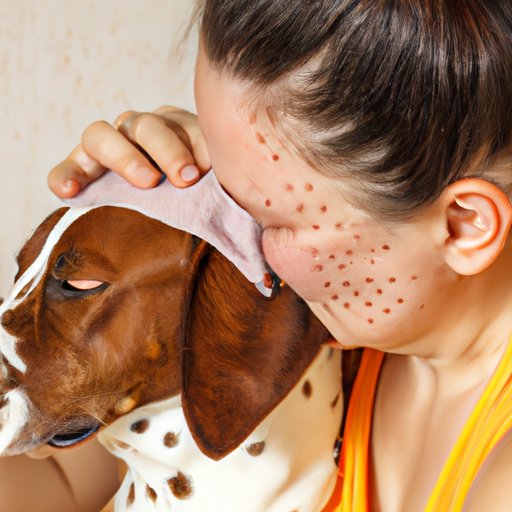Introduction
Hot spots, or acute moist dermatitis, are one of the most common skin conditions that affect dogs. It is an infection of the skin caused by bacteria, fungus, parasites, or allergies. Hot spots can be very painful and cause discomfort for your pup, so it’s important to take action quickly to treat the condition. This article will provide a comprehensive guide on how to treat hot spots on dogs at home.

Definition of Hot Spots on Dogs
Hot spots on dogs are red, irritated patches of skin that appear suddenly and can spread rapidly. They often have a moist appearance and are usually accompanied by intense itching. The affected area may also be tender and warm to the touch. In severe cases, the area may ooze pus and the fur may be matted down.

Overview of Symptoms and Causes
The most common symptom of hot spots is intense itching, which can lead to excessive licking, biting, and scratching of the affected area. This can further aggravate the condition and cause the hot spot to grow in size.
The exact cause of hot spots is not always known, but there are several factors that can contribute to their development, including fleas, allergies, poor grooming, skin infections, and hormonal imbalances.
Keeping the Area Clean and Dry
One of the most important steps in treating hot spots is keeping the area clean and dry. This helps to prevent the spread of bacteria and reduce irritation.
Cleaning the Area with Non-Irritating Cleanser
Start by gently cleaning the area with a non-irritating cleanser, such as diluted baby shampoo. Avoid using soap, as this can be too harsh and further irritate the affected area. Gently massage the cleanser into the area and rinse thoroughly with warm water.
Drying the Area Thoroughly
Once the area is cleaned, make sure to dry it thoroughly. Use a clean towel or soft cloth to pat the area dry. You may also use a blow dryer set on low heat to speed up the process. Be sure to keep the blow dryer at least 6 inches away from the skin to avoid burning.
Trimming Excess Hair
In some cases, it may be necessary to trim the excess hair around the hot spot. This helps to keep the area clean and dry and prevents the fur from matting down and trapping moisture.
Reasons for Trimming Hair
Excess hair can trap moisture, which can lead to bacterial growth and further irritation of the area. Trimming the hair also makes it easier to apply topical treatments and can help the hot spot heal more quickly.
Proper Technique for Hair Removal
If you decide to trim the hair around the hot spot, it’s important to do it properly. Start by combing the fur to remove any tangles and knots. Next, use a pair of scissors to carefully trim the hair around the affected area. Make sure to avoid cutting the skin.

Applying a Poultice or Compress
Using a poultice or compress can help to soothe the area and promote healing. These treatments draw out moisture, reduce inflammation, and provide relief from itching.
Benefits of Using a Poultice or Compress
A poultice or compress helps to draw out moisture and reduce inflammation. They also provide relief from itching, which can help to prevent your pup from further irritating the hot spot.
How to Properly Apply These Treatments
To apply a poultice or compress, start by soaking a clean cloth in a mixture of equal parts warm water and apple cider vinegar. Squeeze out the excess liquid and then apply the cloth to the hot spot. Leave it on for 10-15 minutes before removing.
Utilizing Natural Remedies
There are several natural remedies that can help to treat hot spots on dogs. These include aloe vera, coconut oil, honey, and tea tree oil.
Popular Natural Remedies for Hot Spots
Aloe vera is a popular natural remedy for hot spots. It has anti-inflammatory and antibacterial properties that help to reduce irritation and promote healing. Coconut oil is also beneficial, as it helps to soothe the area and keep it moisturized. Honey is another effective remedy, as it has antiseptic and antibacterial properties that help to reduce inflammation and kill bacteria. Tea tree oil is also beneficial, as it helps to reduce itching and promote healing.
Proper Dosage and Administration
It’s important to follow the proper dosage and administration instructions when using any of these natural remedies. For instance, aloe vera should be applied topically to the affected area twice a day. Coconut oil should be massaged into the skin once or twice a day. Honey should be applied topically and left on for 10-15 minutes before being washed off. And tea tree oil should be diluted with water and applied topically to the hot spot twice a day.
Seeking Veterinary Care if Necessary
In some cases, it may be necessary to seek veterinary care if the hot spot does not respond to home treatment.
Recognizing when it’s Time to Seek Professional Help
If the hot spot does not improve within a few days, or if it continues to spread, it’s important to seek veterinary care. Your vet may recommend further tests to determine the underlying cause of the hot spot.
Types of Treatments that May be Recommended
Your vet may prescribe antibiotics, anti-inflammatory medications, or other treatments to help clear up the hot spot. They may also recommend special shampoos or creams to help soothe the area and promote healing.
Conclusion
Hot spots can be painful and uncomfortable for your pup, so it’s important to take action quickly to treat them. This article provided a comprehensive guide on how to treat hot spots on dogs at home. Keeping the area clean and dry, trimming excess hair, applying a poultice or compress, utilizing natural remedies, and seeking veterinary care if necessary are all important steps in treating hot spots.


